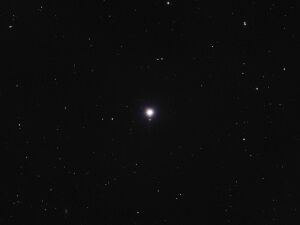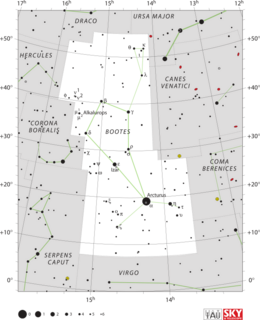Astronomy:Theta Boötis
| Observation data Equinox J2000.0]] (ICRS) | |
|---|---|
| Constellation | Boötes |
| Right ascension | 14h 25m 11.79703s[1] |
| Declination | +51° 51′ 02.6769″[1] |
| Apparent magnitude (V) | 4.05[2] + 13.23[3] |
| Characteristics | |
| Spectral type | F7 V[2] + M2.5V[3] |
| U−B color index | −0.02[4] |
| B−V color index | +0.50[2] |
| Astrometry | |
| Radial velocity (Rv) | −10.627±0.0065[5] km/s |
| Proper motion (μ) | RA: −235.40[1] mas/yr Dec.: −399.07[1] mas/yr |
| Parallax (π) | 68.82 ± 0.14[1] mas |
| Distance | 47.39 ± 0.10 ly (14.53 ± 0.03 pc) |
| Absolute magnitude (MV) | 3.25[6] |
| Details | |
| A | |
| Mass | 1.41 M☉[7] 1.24[8] M☉ |
| Radius | 1.733±0.011[9] R☉ |
| Luminosity | 4.131±0.096[9] L☉ |
| Surface gravity (log g) | 4.07[8] cgs |
| Temperature | 6,294±40[8] K |
| Metallicity [Fe/H] | 0.03[8] dex |
| Rotational velocity (v sin i) | 29.2[10] km/s |
| Age | 3.1 Gyr[11] 3.83[8] Gyr |
| B | |
| Mass | 0.21[7] M☉ |
| Other designations | |
| Database references | |
| SIMBAD | data |
| ARICNS | data |
Theta Boötis, Latinized from θ Boötis, is a star in the northern constellation of Boötes the herdsman, forming a corner of the upraised left hand of this asterism.[13] It has the traditional name Asellus Primus (/əˈsɛləs ˈpraɪməs/; Latin for "first donkey colt")[13] and the Flamsteed designation 23 Boötis. Faintly visible to the naked eye, this star has a yellow-white hue with an apparent visual magnitude of 4.05.[2] It is located at a distance of 47 light years from the Sun based on parallax, but is drifting closer with a radial velocity of −10.6 km/s.[5]
Properties
The stellar classification of Theta Boötis is F7 V,[2] matching an F-type main-sequence star. It is a solar-type star that may be near the end of its main sequence lifetime based on a high luminosity for a star of its type.[11] Theta Boötis is a suspected variable star[14] and a source of X-ray emission.[15] There is evidence for low amplitude radial velocity variation of about 5 km/s.[11] The star has a greater mass and a larger radius than the Sun. It is about 3–4 billion years old and is spinning with a projected rotational velocity of 29 km/s.[10] The star is radiating 4.1[9] times the luminosity of the Sun from its photosphere at an effective temperature of 6,294 K.[8]
There is a nearby 11th magnitude optical companion star about 70 arcseconds away. This is a class M2.5 red dwarf that is separated by a minimum of 1,000 AUs. It is uncertain whether they are gravitationally bound, but they do have a common motion through space and so the two stars probably share a common origin.[16][3]
Nomenclature
θ Boötis, along with the other Aselli (ι Boo and κ Boo) and λ Boo, were Aulād al Dhiʼbah (أولاد الضّباع - awlād al-ḍibā‘), "the Whelps of the Hyenas".[13]
In Chinese, 天枪 (Tiān Qiāng), meaning Celestial Spear, refers to an asterism consisting of θ Boötis, κ2 Boötis and ι Boötis.[17] Consequently, the Chinese name for θ Boötis itself is 天枪三 (Tiān Qiāng sān, English: the Third Star of Celestial Spear.)[18]
References
- ↑ 1.0 1.1 1.2 1.3 1.4 van Leeuwen, F. (November 2007), "Validation of the new Hipparcos reduction", Astronomy and Astrophysics 474 (2): 653–664, doi:10.1051/0004-6361:20078357, Bibcode: 2007A&A...474..653V
- ↑ 2.0 2.1 2.2 2.3 2.4 Malagnini, M. L.; Morossi, C. (November 1990), "Accurate absolute luminosities, effective temperatures, radii, masses and surface gravities for a selected sample of field stars", Astronomy and Astrophysics Supplement Series 85 (3): 1015–1019, Bibcode: 1990A&AS...85.1015M
- ↑ 3.0 3.1 3.2 Lépine, Sébastien; Bongiorno, Bethany (March 2007), "New Distant Companions to Known Nearby Stars. II. Faint Companions of Hipparcos Stars and the Frequency of Wide Binary Systems", The Astronomical Journal 133 (3): 889–905, doi:10.1086/510333, Bibcode: 2007AJ....133..889L.
- ↑ Mermilliod, J.-C. (1986), "Compilation of Eggen's UBV data, transformed to UBV (unpublished)", Catalogue of Eggen's UBV Data. SIMBAD, Bibcode: 1986EgUBV........0M
- ↑ 5.0 5.1 Soubiran, C. et al. (2018), "Gaia Data Release 2. The catalogue of radial velocity standard stars", Astronomy and Astrophysics 616: A7, doi:10.1051/0004-6361/201832795, Bibcode: 2018A&A...616A...7S.
- ↑ Holmberg, J. et al. (July 2009), "The Geneva-Copenhagen survey of the solar neighbourhood. III. Improved distances, ages, and kinematics", Astronomy and Astrophysics 501 (3): 941–947, doi:10.1051/0004-6361/200811191, Bibcode: 2009A&A...501..941H.
- ↑ 7.0 7.1 Tokovinin, A.; Kiyaeva, O. (February 21, 2016), "Eccentricity distribution of wide binaries", Monthly Notices of the Royal Astronomical Society 456 (2): 2070–2079, doi:10.1093/mnras/stv2825, Bibcode: 2016MNRAS.456.2070T.
- ↑ 8.0 8.1 8.2 8.3 8.4 8.5 Luck, R. Earle (January 2017), "Abundances in the Local Region II: F, G, and K Dwarfs and Subgiants", The Astronomical Journal 153 (1): 19, doi:10.3847/1538-3881/153/1/21, 21, Bibcode: 2017AJ....153...21L.
- ↑ 9.0 9.1 9.2 Boyajian, Tabetha S. et al. (February 2012), "Stellar Diameters and Temperatures. I. Main-sequence A, F, and G Stars", The Astrophysical Journal 746 (1): 101, doi:10.1088/0004-637X/746/1/101, Bibcode: 2012ApJ...746..101B.. See Table 10.
- ↑ 10.0 10.1 Schröder, C.; Reiners, Ansgar; Schmitt, Jürgen H. M. M. (January 2009), "Ca II HK emission in rapidly rotating stars. Evidence for an onset of the solar-type dynamo", Astronomy and Astrophysics 493 (3): 1099–1107, doi:10.1051/0004-6361:200810377, Bibcode: 2009A&A...493.1099S, http://goedoc.uni-goettingen.de/goescholar/bitstream/handle/1/9690/aa10377-08.pdf?sequence=2[yes|permanent dead link|dead link}}]
- ↑ 11.0 11.1 11.2 Rachford, Brian L.; Foight, Dillon R. (June 2009), "Chromospheric Variability in Early F-Type Stars", The Astrophysical Journal 698 (1): 786–802, doi:10.1088/0004-637X/698/1/786, Bibcode: 2009ApJ...698..786R.
- ↑ "tet Boo". SIMBAD. Centre de données astronomiques de Strasbourg. http://simbad.u-strasbg.fr/simbad/sim-basic?Ident=tet+Boo.
- ↑ 13.0 13.1 13.2 Star Names: Their Lore and Meaning (Reprint ed.), New York, NY: Dover Publications Inc, 1963, p. 105, ISBN 0-486-21079-0, https://penelope.uchicago.edu/Thayer/E/Gazetteer/Topics/astronomy/_Texts/secondary/ALLSTA/Bootes*.html, retrieved 2010-12-12.
- ↑ Samus', N. N; Kazarovets, E. V; Durlevich, O. V; Kireeva, N. N; Pastukhova, E. N (2017), "General catalogue of variable stars: Version GCVS 5.1", Astronomy Reports 61 (1): 80, doi:10.1134/S1063772917010085, Bibcode: 2017ARep...61...80S.
- ↑ Haakonsen, Christian Bernt; Rutledge, Robert E. (September 2009), "XID II: Statistical Cross-Association of ROSAT Bright Source Catalog X-ray Sources with 2MASS Point Source Catalog Near-Infrared Sources", The Astrophysical Journal Supplement 184 (1): 138–151, doi:10.1088/0067-0049/184/1/138, Bibcode: 2009ApJS..184..138H.
- ↑ Kaler, James, "Asellus Primus", Stars (University of Illinois), http://stars.astro.illinois.edu/sow/asellusp.html, retrieved 2016-01-07.
- ↑ (in Chinese) 中國星座神話, written by 陳久金. Published by 台灣書房出版有限公司, 2005, ISBN:978-986-7332-25-7.
- ↑ (in Chinese) 香港太空館 - 研究資源 - 亮星中英對照表 , Hong Kong Space Museum. Accessed on line November 23, 2010.
External links
 |



